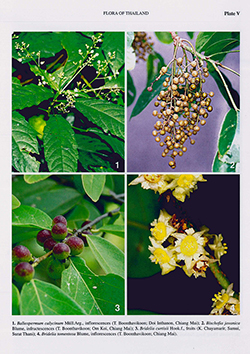e-Flora of Thailand
Volume 8 > Part 1 > Year 2005 > Page 143 > Euphorbiaceae > Bridelia
3. Bridelia curtisii Hook.f.wfo-0000417921
Fl. Brit. Ind. 5: 273. 1887; Boerl., Handl. 3: 271. 1900; Rid., Fl. Malay, Penins. 3: 184. 1924; Dressler, Blumea 41: 278, map 1, 1996; Dressler & Welzen in Welzen et al., Thai Forest Bull., Bot. 28: 61. 2000.— Bridelia ovata var. curtisii (Hook.f.) Airy Shaw, Kew Bull. 26: 229. 1972. Plate V: 3.
Accepted Name : This is currently accepted.
Description : Scrambling shrub to tree up to 7 m high; branchlets glabrous to puberulous, with scattered lenticels. Stipules narrowly triangular, up to 4 by 0.6–0.7 mm, glabrous, early caducous. Leaves: petiole 3.5–6 mm long, rarely puberulous; blade narrowly elliptic to) oblong with parallel sides, 3–8 by 1–3.6 cm, length/width ratio (1.5–)2–2.8, rigidly coriaceous, glabrous (to some hairs on nerves), base mainly rounded to obtuse, margin entire, apex rounded (to bluntly acute); venation prominent on both sides, nerves in 5–10(–12) pairs, joining marginal vein, tertiary veins usually reticulate. Inflorescences glomerules in axils of normal leaves, with up to 12 sessile flowers. Flowers green; staminate ones 3–5 mm in diam.; pistillate ones 4–5 mm in diam., pedicel rarely up to 1 mm long; sepals triangular-ovate, 1.5–3 by 1–1.5 mm, glabrous, greenish yellow; petals variable in shape, up to 1 by 0.7 mm, whitish yellow, base cuneate to spathulate, apex roundish, notched or lobulate. Stamens: staminal column ca 1 by 0.3 mm; free part of filaments up to 0.7 mm long; anthers ellipsoid, 0.6–0.7 by 0.3–0.4 mm; ovary globose, ca 1.5 mm in diam.; styles 2, only basally united, with stigmas up to 1.2 mm long; stigmas deeply bifid. Fruits 2 or 3(–6) per glomerule, depressed-ovoid, apically emarginate, slightly bilobate, 4.5–6.5 mm in diam., 2-locular, greenish purple to black; endocarp 2, semigloboid, ca 4 by 5 by 2.5 mm, brown. Seeds semigloboid to ovoid, with lateral furrow, ca 3 by 4 by 2 mm, brown.
Thailand : NORTHERN: Chiang Mai (Bo Luang, Mae Sanam), Mae Hong Son (Mae Taeng-Pai), Lamphun (Doi Khun Tan); CENTRAL: Suphan Buri (U-thong), Nakhon Nayok (Khao Yai NP), Krung Thep Maha Nakhon (Bangkok) (Thon Buri, Klong San); EASTERN: Ubon Ratchathani (Kaeng Saphoe); PENINSULAR: Surat Thani (Tasae, Khao Nam Ron), Krabi (Ko Pipi), Yala (Banang Sata).
Distribution : Vietnam, Cambodia, Andaman and Nicobar Islands, Malay Peninsula (type), N Sumatra.
Ecology : Mangrove, tidal riversides, evergreen forests, open and disturbed areas (savannas), road sides, often on limestone, 10–1,000 m alt.
Vernacular : Maka bai na (มะกาใบหนา).
Uses: The fruits are edible and medicinally used in Cambodia (Martin 155 -L).

